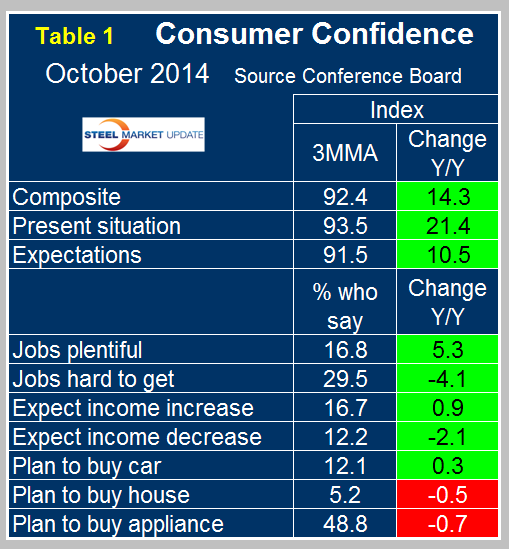Market Data

October 29, 2014
Consumer Confidence in October 2014
Written by Peter Wright
The consumer confidence index as reported by the Conference Board bounced back in October and the dismal September results were revised upwards. The composite rose from 89.0 (first reported as 86.0) to 94.9, the view of the present situation rose from 93.0 (first reported as 89.4) to 93.7 as expectations rose from 86.4 (first reported as 83.7) to 95.0. Which just goes to prove that first estimates should be treated with caution and that a three month moving average, (3MMA) is a much better guide to a true situation. On closer examination it looks as though the September view of expectations was an outlier. After revision the September view of the present situation came back in line. The 3MMA of the composite, the view of the present situation and expectations are shown in Figure 1. The present situation component has been much more volatile that expectations since our data began 34 years ago. History suggests that we are now entering a period when the view of the present situation will move ahead of expectations.
On a year over year basis using a 3MMA the composite is up by 14.3 lead by consumers view of the present situation which is up by 21.4, (Table 1). The employment sub-indexes, job availability and wage expectations, are improving. Intentions to buy both a house and an appliance became negative in May year over year and continued to be negative each month since then. May was the first time in over a year that housing had been negative, intentions regarding appliances tend to be more erratic. Compared to the same month a year ago, intentions to buy a car have been positive each month since May.
The official statement from the Conference Board which interestingly says nothing about the revisions to September data reads as follows:
The Conference Board Consumer Confidence Index Rebounds
The Conference Board Consumer Confidence Index, which had decreased in September, rebounded in October. The Index now stands at 94.5 (1985=100), up from 89.0 in September. The Present Situation Index edged up from 93.0 to 93.7, while the Expectations Index increased sharply to 95.0 from 86.4 in September.
The monthly Consumer Confidence Survey, based on a probability-design random sample, is conducted for The Conference Board by Nielsen, a leading global provider of information and analytics around what consumers buy and watch. The cutoff date for the preliminary results was October 16.
Says Lynn Franco, Director of Economic Indicators at The Conference Board: “Consumer confidence, which had declined in September, rebounded in October. A more favorable assessment of the current job market and business conditions contributed to the improvement in consumers’ view of the present situation. Looking ahead, consumers have regained confidence in the short-term outlook for the economy and labor market, and are more optimistic about their future earnings potential. With the holiday season around the corner, this boost in confidence should be a welcome sign for retailers.”
Consumers’ appraisal of current conditions was moderately more favorable in October than in September. Their view of business conditions was mixed; while the proportion saying conditions are “good” inched up from 24.2 percent to 24.5 percent, those claiming business conditions are “bad” also increased slightly, from 21.2 percent to 21.7 percent. Consumers’ assessment of the job market improved moderately, with the proportion stating jobs are “plentiful” increasing marginally from 16.3 percent to 16.5 percent, and those claiming jobs are “hard to get” declining slightly from 29.4 percent to 29.1 percent.
Consumers’ optimism, which had declined considerably in September, improved in October. The percentage of consumers expecting business conditions to improve over the next six months increased from 19.0 percent to 19.6 percent, while those expecting business conditions to worsen fell from 11.4 percent to 9.3 percent. Consumers’ outlook for the labor market also improved markedly. Those anticipating more jobs in the months ahead increased to 16.8 percent from 16.0 percent, while those anticipating fewer jobs fell from 16.9 percent to 13.9 percent. The proportion of consumers expecting growth in their incomes rose from 16.9 percent in September to 17.7 percent in October, while the proportion expecting a drop in income fell from 13.4 percent to 11.6 percent. (Sources: The Conference Board and SMU Analysis)









